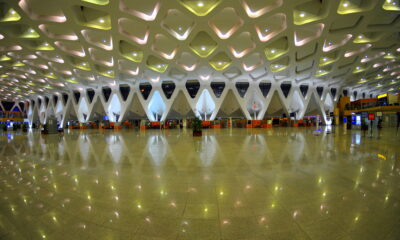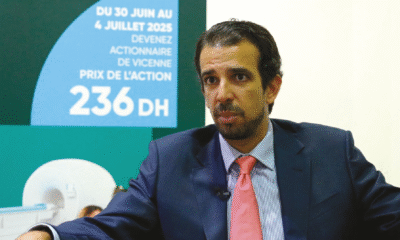Business
King Mohammed VI launches the construction works for the Kenitra-Marrakech High-Speed Rail Line
His Majesty King Mohammed VI proceeded today in Rabat to launch the construction works for the Kenitra-Marrakech High-Speed Rail Line. With this new project, travel times will be 1 hour between Tangier and Rabat, 1 hour 40 minutes between Tangier and Casablanca, and 2 hours 40 minutes between Tangier and Marrakech (a time saving of more than 2 hours).

His Majesty Mohammed VI launched, on Thursday at Rabat-Agdal train station, the construction works for the Kenitra-Marrakech High-Speed Rail Line (LGV), with a length of about 430 kilometers.
The Kenitra-Marrakech LGV project reflects the Sovereign’s enlightened vision for improving the national rail service and fits within the Kingdom’s strategic guidelines under the impetus of His Majesty the King, especially regarding sustainable development and the promotion of collective mobility solutions with a low carbon footprint.
It also illustrates Morocco’s firm determination to continue developing the national rail network so it can fully play its role as the backbone of a sustainable and inclusive transport system.
This structuring project, with a budget of 53 billion dirhams (excluding rolling stock), is part of an ambitious program mobilizing a total investment of 96 billion dirhams. This includes the acquisition of 168 trains for 29 billion dirhams, aimed at renewing the existing ONCF (National Railways Office) fleet, supporting development projects, and maintaining performance for 14 billion dirhams. It will also enable the development of three metropolitan transport networks in the Casablanca, Rabat, and Marrakech areas.
The Kenitra-Marrakech LGV project involves creating a high-speed rail line connecting Rabat, Casablanca, and Marrakech, serving the airports of Rabat and Casablanca. With this new project, travel times will be 1 hour between Tangier and Rabat, 1 hour 40 minutes between Tangier and Casablanca, and 2 hours 40 minutes between Tangier and Marrakech (saving more than 2 hours). The project will also connect Rabat to Casablanca’s Mohammed V International Airport in 35 minutes, serving the new Benslimane stadium. A high-speed service between Fez and Marrakech is also planned, with a travel time of 3 hours 40 minutes (using high-speed trains on the classic line from Fez to north of Kenitra, then on the new high-speed line to Marrakech).
The LGV Kenitra-Marrakech project includes designing and building a new line between Kenitra and Marrakech designed for speeds of 350 km/h, upgrades at the terminal areas of Rabat, Casablanca, and Marrakech (works on active tracks), railway equipment, construction of new high-speed train stations and local train stations, and upgrading existing stations, as well as building a maintenance center for trainsets in Marrakech.
Extending the LGV to Marrakech will free up capacity on the classic network, enabling the development of significant metropolitan train services (TMP) to meet public transport needs in Rabat, Casablanca, and Marrakech. This new TMP service addresses urban mobility challenges in these three metropolitan areas, offering advantages in punctuality, service quality, and sustainability.
Alongside the new Kenitra-Marrakech High-Speed Line project, ONCF is launching an unprecedented program to acquire 168 new trains, aiming to strengthen and modernize the entire passenger fleet. With an investment of 29 billion dirhams, this acquisition will improve operational performance, strengthen regional services, and meet the expected increase in traffic by 2030. Specifically, the acquisition includes 18 high-speed trains for expansion projects, 40 trains for line services, 60 rapid shuttle trains (TNR), and 50 for the public transport network in the three metropolitan areas.
This ambitious rolling stock acquisition program will also enable the emergence of an industrial railway ecosystem, with a local integration rate exceeding 40%, demonstrating strong commitment to Moroccan enterprises and skills, and will have positive implications for supporting the national economy, reducing transport costs, and promoting sustainable development.
The program has two main components: the first is industrial, involving the establishment and launch of a train manufacturing unit and the development of a supplier and subcontractor ecosystem; the second is the creation of a joint venture between manufacturers and ONCF to ensure ongoing and industrial maintenance throughout the trains’ lifespan, with cost control.
Spanning 10 years, this program will enable the training of specialized human resources and the creation of several thousand direct and indirect jobs.
With this modernization project, Morocco’s entire rail network is experiencing a true renaissance, not only extending the high-speed network to Marrakech but also modernizing, strengthening, and renewing the ONCF train fleet, creating a rail-based public transport network, and fostering a new industrial ecosystem.
This major investment and modernization project for the rail network has relied on the expertise of renowned international companies, including France’s Alstom for high-speed rolling stock, Spain’s CAF for inter-city trains (200 km/h), and South Korea’s Hyundai Rotem for metropolitan trains, with preferential financing terms













